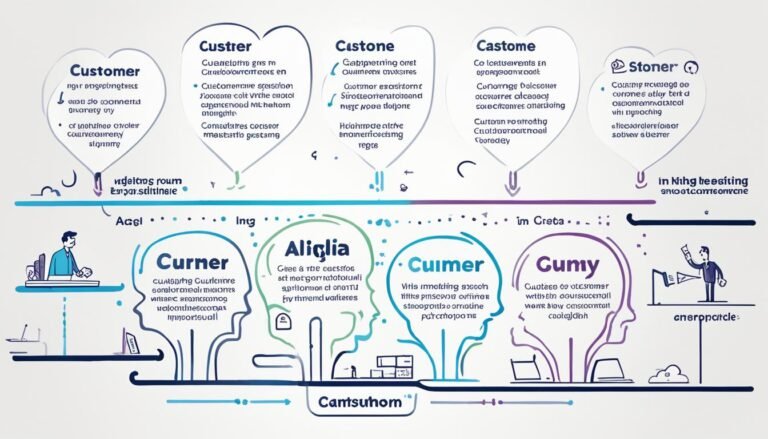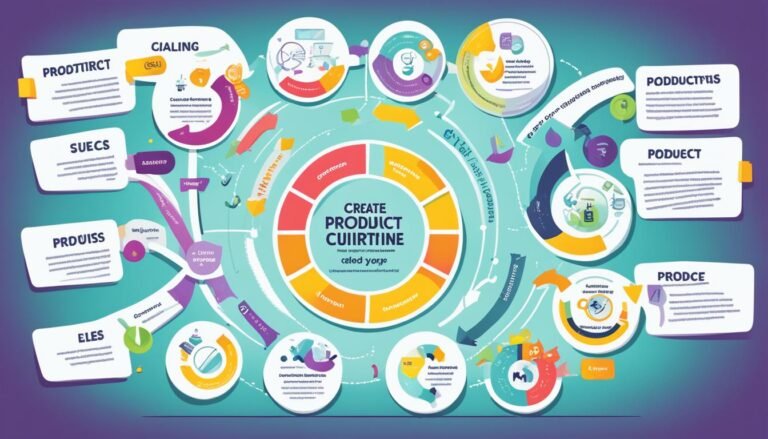Neuromarketing Techniques
Are you tired of traditional marketing methods that seem to miss the mark when it comes to truly understanding your target audience? Well, fear not, because there is a fascinating world of neuromarketing techniques waiting for you to explore.
These techniques tap into the intricate workings of the human brain, allowing you to delve into the subconscious and unlock the secrets behind consumer behavior. From leveraging emotional triggers to utilizing cutting-edge technology, neuromarketing offers a tantalizing glimpse into the future of marketing.
So, if you're ready to revolutionize your approach and gain a competitive edge, prepare to embark on a journey where science meets marketing genius.
Key Takeaways
- Cognitive biases, such as confirmation bias and anchoring bias, impact decision-making in neuromarketing.
- Emotions, including happiness, fear, anger, and sadness, strongly influence consumer decision-making.
- Eye-tracking technology provides valuable real-time insights into subconscious responses and allows for immediate adjustments in neuromarketing strategies.
- Neuro-design techniques, such as using colors, shapes, typography, and imagery, enhance branding strategies by eliciting emotional responses and optimizing the placement of branding elements.
Understanding the Brain's Decision-Making Process
To truly comprehend the intricacies of consumer decision-making, it's imperative to delve into the inner workings of the human brain. Understanding cognitive biases and decoding subconscious motivations are key factors in this endeavor.
Cognitive biases are systematic errors in thinking that can influence our decision-making process. They're deeply rooted in our subconscious and can greatly impact our choices without us even realizing it. One common cognitive bias is the confirmation bias, where we tend to seek information that confirms our existing beliefs and ignore or downplay contradictory evidence. This bias can lead us to make decisions based on incomplete or biased information, rather than considering all available options objectively.
Another important cognitive bias is the anchoring bias, which occurs when we rely too heavily on the first piece of information we encounter. This bias can influence our judgments and decisions, as it sets a reference point that subsequent information is compared to. Marketers can take advantage of this bias by strategically framing their products or prices to create a favorable anchoring effect.
Decoding subconscious motivations is another crucial aspect of understanding the brain's decision-making process. Our subconscious mind plays a significant role in guiding our behaviors and preferences, often without our conscious awareness. By uncovering these hidden motivations, marketers can tailor their strategies to appeal to consumers on a deeper level.
Leveraging Emotional Triggers
Understanding the cognitive biases and subconscious motivations behind consumer decision-making leads us to the next crucial step: leveraging emotional triggers. In the world of neuromarketing techniques, understanding and harnessing emotional impact is essential for effective marketing strategies.
Emotions play a significant role in consumer decision-making, often guiding preferences and influencing purchasing behavior. By leveraging emotional triggers, marketers can tap into the subconscious desires of consumers, ultimately driving them to make purchasing decisions.
To leverage emotional triggers effectively, marketers must first understand the key emotions that drive consumer behavior. Emotions such as happiness, fear, anger, and sadness can all have a profound impact on decision-making. By identifying the emotions most relevant to their target audience, marketers can create campaigns that resonate deeply and elicit the desired emotional response.
Once the emotional triggers are identified, marketers can employ various techniques to leverage them. Storytelling, for example, is a powerful tool that can evoke emotions and create a lasting impression. By crafting narratives that connect with consumers on an emotional level, marketers can forge deeper connections and influence their decision-making.
Another technique is the use of visual cues and imagery. Studies have shown that visual stimuli can evoke strong emotional responses and enhance memory recall. By incorporating visually appealing elements that align with the desired emotional triggers, marketers can create a lasting impact on consumers.
Utilizing Eye-Tracking Technology
Eye-tracking technology is a powerful tool that enables marketers to gain valuable insights into consumer attention and behavior. By tracking eye movements and fixations, this technology provides a window into the subconscious mind, revealing what captures the viewer's attention and how they engage with visual stimuli.
Here are some advantages and limitations of eye-tracking technology:
Advantages:
- Objective measurement: Eye-tracking provides objective data on where consumers look, allowing marketers to understand what elements of their marketing materials are attracting attention.
- Real-time insights: Marketers can observe and analyze consumer behavior in real-time, allowing for immediate adjustments and improvements to marketing strategies.
- Unconscious responses: Eye-tracking reveals subconscious responses, providing insights into consumers' true preferences, even when they may not be consciously aware of them.
Limitations:
- Limited sample size: Eye-tracking studies tend to involve a small number of participants, which may limit the generalizability of the findings.
- Artificial environment: Eye-tracking studies often take place in controlled laboratory settings, which may not accurately reflect real-world consumer behavior.
- Interpretation challenges: Interpreting eye-tracking data requires expertise and careful analysis, as eye movements don't always directly correlate with consumer preferences or purchase intent.
Despite these limitations, eye-tracking technology remains a valuable tool for marketers seeking to understand and optimize consumer attention and behavior. By leveraging its advantages and recognizing its limitations, marketers can gain valuable insights into their target audience and develop more effective marketing strategies.
Enhancing Branding Through Neuro-Design
By harnessing the power of neuro-design, marketers can further enhance their branding strategies, building upon the valuable insights gained through eye-tracking technology to create more impactful and engaging consumer experiences.
Neuro-design techniques, rooted in the understanding of how the brain processes visual information, offer a scientific and analytical approach to enhancing brand recognition.
Neuro-design involves the application of neuroscience principles to design elements such as colors, shapes, typography, and imagery. By utilizing these techniques, marketers can tap into the subconscious mind of consumers, eliciting emotional responses that strengthen brand associations.
For instance, neuro-design can leverage the brain's preference for symmetry and balance to create visually appealing logos and packaging. By incorporating elements that align with the brain's natural visual processing, brands can establish a more memorable and recognizable identity.
Moreover, neuro-design can optimize the placement of branding elements within advertisements and product displays. Eye-tracking technology can provide insights into the areas of visual attention, allowing marketers to strategically position logos, slogans, and product images to capture consumers' focal points.
Creating Compelling Storytelling Techniques
To effectively engage consumers and leave a lasting impact, marketers must harness the power of compelling storytelling techniques rooted in neuroscience principles. By understanding how the brain processes information and emotions, marketers can create narratives that captivate audiences and evoke an emotional response.
Here are three sub-lists of storytelling techniques to consider:
- Develop a compelling character:
- Craft a protagonist that the audience can relate to and empathize with.
- Give the character a distinct personality, desires, and challenges.
- Show the character's growth and transformation throughout the narrative.
- Structure the narrative effectively:
- Begin with a strong opening that grabs the audience's attention.
- Establish a clear conflict or tension that drives the story forward.
- Create rising action, climax, and resolution to maintain suspense and satisfaction.
- Incorporate emotional triggers:
- Use sensory details to engage the audience's senses and create a vivid experience.
- Appeal to universal emotions such as joy, fear, love, or sadness.
- Utilize storytelling elements like suspense, surprise, or humor to keep the audience engaged.
Harnessing the Power of Social Proof
To effectively harness the power of social proof, it's crucial to understand its impact on influencing consumer behavior.
By leveraging social validation, marketers can tap into the innate human desire for acceptance and belonging.
This technique capitalizes on the idea that people are more likely to trust and engage with a product or service if they see others doing the same, making social proof a persuasive tool in neuromarketing strategies.
Influencing Consumer Behavior
Harness the power of social proof to effectively influence consumer behavior. In the consumer decision-making process, subconscious influences play a significant role in shaping purchasing decisions. By understanding and leveraging these subconscious influences, marketers can successfully sway consumer behavior.
Here are three ways to evoke an emotional response in the audience:
- Testimonials: Share positive experiences and testimonials from satisfied customers to create a sense of trust and credibility.
- Social media influencers: Collaborate with popular influencers who align with your brand to tap into their loyal following and leverage the power of their influence.
- User-generated content: Encourage customers to share their experiences with your product or service on social media platforms, creating a sense of authenticity and peer validation.
Leveraging Social Validation
By understanding the subconscious influences that shape consumer behavior, you can effectively leverage social validation, harnessing the power of social proof to influence purchasing decisions.
Peer acceptance and social conformity play significant roles in shaping our choices as consumers. Humans have an innate desire to fit in and be accepted by their peers. This need for acceptance drives us to conform to the behaviors and choices of others.
Marketers can tap into this psychological phenomenon by highlighting the popularity and positive feedback of a product or service. By showcasing testimonials, customer reviews, and social media engagement, marketers can create a sense of social validation and proof, increasing the likelihood of consumers making a purchase.
This strategy takes advantage of our desire to conform and be part of the group, ultimately influencing our purchasing decisions.
Optimizing Pricing Strategies With Neuroeconomics
Using neuroeconomics to optimize pricing strategies can provide valuable insights into consumer decision-making processes. By incorporating neuroeconomic pricing models and psychological pricing strategies, businesses can effectively influence consumer behavior and maximize profits.
Here are three ways in which neuroeconomics can help optimize pricing strategies:
- Anchoring effect: Neuroeconomics research has shown that consumers tend to rely heavily on the first piece of information they receive when making a purchasing decision. By strategically setting a higher initial price as an anchor, businesses can create a perception of value and make subsequent prices seem more reasonable.
- Price framing: Neuroeconomics studies have demonstrated that how a price is presented can significantly impact consumer perception. By framing prices in terms of percentages or savings, businesses can create a sense of urgency and increase the perceived value for customers.
- Decoy pricing: Neuroeconomics suggests that introducing a third option, known as a decoy, can influence consumer choices. By strategically pricing a decoy product slightly higher than the target product, businesses can steer consumers towards the desired choice and increase overall sales.
Incorporating neuroeconomics into pricing strategies allows businesses to tap into the subconscious factors that influence consumer decision-making. By understanding these underlying processes, businesses can more effectively shape consumer behavior and drive sales.
Applying Neuro-Linguistic Programming (NLP) in Marketing
Neuroeconomics has proven to be a powerful tool for optimizing pricing strategies. Applying Neuro-Linguistic Programming (NLP) in marketing can further enhance the effectiveness of these strategies.
Neuro-Linguistic Programming is a psychological approach that focuses on the connection between language, behavior, and thoughts. By utilizing NLP techniques, marketers can tap into the subconscious mind of consumers and employ subconscious persuasion techniques to influence their purchasing decisions.
One key NLP technique is mirroring, which involves subtly imitating the body language and speech patterns of the target audience. This technique establishes rapport and trust, making consumers more receptive to marketing messages.
Another technique is anchoring, which involves associating a particular emotion or feeling with a product or brand. By creating positive emotional associations, marketers can increase the likelihood of consumers choosing their product over competitors.
Additionally, using language patterns such as embedded commands or sensory-rich descriptions can elicit specific responses from consumers, further influencing their decision-making process.
Applying NLP techniques in marketing allows for a deeper understanding of consumer behavior and how to effectively engage with them. By tapping into the subconscious mind, marketers can create persuasive messages that resonate with consumers on a deeper level.
Incorporating NLP techniques into marketing strategies can lead to increased brand loyalty, higher conversion rates, and ultimately, greater business success.
Influencing Consumer Behavior With Scarcity and Urgency
Limited-time offers, exclusive deals, and the fear of missing out are powerful tools that marketers use to influence consumer behavior. By creating a sense of scarcity and urgency, they tap into our innate desire for exclusivity and our fear of losing out on a valuable opportunity.
These techniques activate the brain's reward system, triggering a sense of excitement and motivation to take immediate action. In this discussion, we'll explore how scarcity and urgency can be leveraged to effectively influence consumer decision-making.
Limited-Time Offers
By creating a sense of scarcity and urgency, marketers can effectively influence consumer behavior through the use of limited-time offers. Exclusive promotions and time-sensitive offers have been proven to evoke emotional responses in consumers, leading to increased engagement and purchases. Here are three ways limited-time offers can impact consumer behavior:
- FOMO (Fear of Missing Out): Limited-time offers create a fear of missing out on a great deal or opportunity. Consumers are motivated to take immediate action to avoid feeling regret or disappointment.
- Perceived value: By offering a limited-time promotion, marketers can create a perception of higher value for the product or service. Consumers believe they're getting a special deal that may not be available later.
- Sense of urgency: Limited-time offers create a sense of urgency, pushing consumers to make quick decisions. This urgency can override rational thinking and impulse purchases are more likely.
Incorporating limited-time offers into marketing strategies can effectively tap into consumers' emotions, driving them to take action before the opportunity disappears.
Exclusive Deals
Incorporating exclusive deals into marketing strategies can effectively leverage the principles of scarcity and urgency to influence consumer behavior. Loyalty programs and personalized discounts are two powerful tools that can be used to create a sense of exclusivity and drive consumer engagement.
Loyalty programs reward customers for their continued support and provide them with exclusive benefits. By offering special discounts or access to limited-edition products, companies can enhance the feeling of exclusivity and encourage customers to remain loyal. This sense of belonging and exclusivity can create a strong emotional connection between the consumer and the brand, resulting in increased customer retention and advocacy.
Personalized discounts, on the other hand, tap into the individual preferences of consumers. By tailoring offers to match their specific needs and desires, companies can make customers feel valued and special. This personal touch enhances the perception of exclusivity and creates a sense of urgency to take advantage of the personalized deal.
Fear of Missing Out
The fear of missing out is a powerful psychological motivator that can be harnessed by marketers to drive consumer behavior through the scarcity and urgency of exclusive offers. By creating a sense of limited availability or time-sensitive promotions, marketers can tap into the innate human desire to be part of something special and not miss out on a unique opportunity.
This fear of missing out, often referred to as FOMO, is particularly amplified in today's society due to the constant exposure to social media and its ability to showcase the exciting experiences and possessions of others. The psychological impact of FOMO can make individuals feel anxious, disconnected, and left behind, making them more susceptible to making impulsive purchasing decisions in order to avoid the fear of missing out.
Marketers can capitalize on this by creating a sense of urgency and scarcity in their marketing campaigns, triggering FOMO and driving consumers to take immediate action.
Measuring and Analyzing Neurological Responses
To effectively measure and analyze neurological responses, it is essential to utilize advanced techniques and methodologies that provide precise and actionable insights. Neuromarketing researchers employ various methods to gather data on brain activity and physiological responses, allowing them to better understand consumer behavior and optimize marketing strategies.
One commonly used technique is analyzing brainwaves, which provides valuable information about cognitive processes and emotional states. Electroencephalography (EEG) is a non-invasive method that measures electrical activity in the brain using electrodes placed on the scalp. By analyzing EEG data, researchers can identify patterns and correlate them with specific stimuli or marketing messages, helping to uncover subconscious reactions and preferences.
Another approach involves measuring physiological responses, such as changes in heart rate, skin conductance, and facial expressions. These physiological measures provide insights into emotional arousal, attention, and engagement. For example, galvanic skin response (GSR) measures changes in sweat gland activity, which can indicate emotional arousal or stress levels. Facial expression analysis, using techniques like facial electromyography (EMG) or computer vision, can help assess emotional responses and gauge consumer reactions to marketing stimuli.
The table below summarizes some of the advanced techniques used in measuring and analyzing neurological responses in neuromarketing research:
| Technique | Description | Advantages |
|---|---|---|
| EEG | Measures electrical activity in the brain using electrodes on the scalp | Non-invasive, provides insights into cognitive processes |
| GSR | Measures changes in sweat gland activity to indicate emotional arousal or stress levels | Non-invasive, provides insights into emotional arousal |
| Facial Expression Analysis | Analyzes facial muscle activity and expressions to assess emotional responses and consumer reactions | Provides insights into emotional engagement and reactions |
Conclusion
In conclusion, utilizing neuromarketing techniques can greatly enhance a company's marketing strategy by tapping into the brain's decision-making process.
One interesting statistic to note is that according to a study conducted by Nielsen, emotional advertising campaigns have been found to be twice as effective at driving sales compared to rational campaigns. This highlights the importance of leveraging emotional triggers in order to create a persuasive and compelling brand message that resonates with consumers on a neurological level.
By understanding and applying these techniques, companies can gain a competitive edge in the marketplace.







